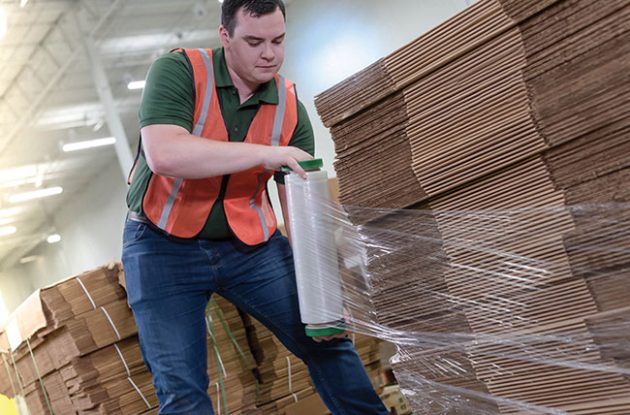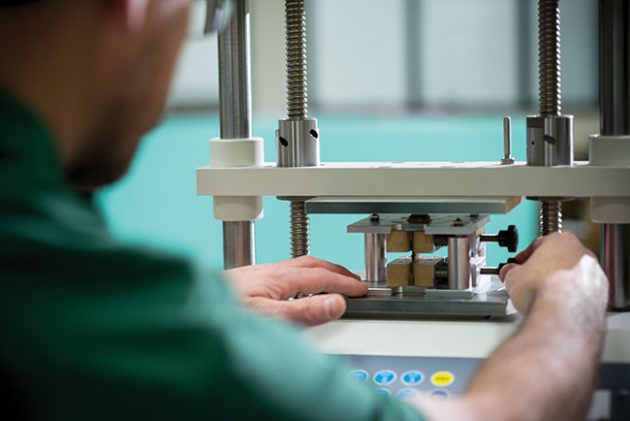
Beyond the film
By Veritiv Corporation
Design & Innovation General Corrugated Film Palletizing ISTA (International Safe Transit Association) Packaging Unwrapped Veritiv CorporationBest practices for effective unit load containment testing
All too often, packaging professionals tend to address their issues with BD&L (breakage, damage and loss) by increasing the number of times a pallet is wrapped with film.
While this Band-Aid solution may temporarily address unit load failure, it drives up film usage and, potentially, labor costs.
Utilizing different methods of palletized unit load testing can help uncover how primary and secondary packaging structures affect the overall containment performance.
“The proper testing procedures result in data that can be used to guide operational changes,” says Jeremy Kell, unit load containment specialist with leading packaging supplies distributor Veritiv Corporation.
“We collaborate with the customers,” Kell says, “and we use a wide range of testing equipment to find data that uncovers the root cause of unit load failures.
“The test results often uncover new opportunities to balance cost with performance,” he states, “while contributing to a safer environment for the workers.”
Developed to help packagers to ensure safe delivery of their shipped goods, ISTA (International Safe Transit Association)-certified testing is designed to mimic the most extreme transit conditions.
Here are a few key ISTA tests that may uncover issues beyond just the film containment force.

Simply adding extra layers of stretchwrap film to stabilize tricky product loads results in unnecessary film waste and potentially significantly higher labor costs.
IMPACT
Impact and drop testing evaluates horizontal or incline impact. Imagine a product on a table that is dropped, mimicking material handling shipping environments, depending on testing criteria.
Just as important as drop testing, advanced incline testing can simulate the lateral forces a unitized load faces during transit. Engineers set a G-force on impact strength, and monitoring devices record how the energy moves through the unitized load.
Post-test analysis of the data can signal areas where packaging materials, such as primary packaging void fill, can be increased or decreased in rigidity to improve performance.
THERMAL SHOCK
Thermal shock testing ensures the packaging materials and products can withstand extreme temperature and humidity fluctuations. Different types of corrugated boxes and flutes are better at withstanding high levels of humidity.
Some companies will see an increase in BD&L as the seasons change. Thermal shock testing can help identify the current limitations of your packaging and help to build a new packaging strategy tailored for different seasons or parts of the world.
VIBRATION
Vibration testing evaluates for fractures, bending, and minor or complete structural failure.
Understanding how vibrations may weaken key parts of the packaging structure can help to identify areas that need a mix of different packaging materials to survive the harsh conditions.
COMPRESSION
Compression testing evaluates how a palletized unit load performs as weight is applied on top. This test simulates the stress caused, as other palletized loads are stacked.
Understanding the compression performance can help companies more fully utilize vertical warehouse space in a safer manner.
Using The right testing methods and mixing different packaging materials can help reduce damage, lower costs, and speed manufacturing, packing and shipping.
As Kell points out, “Film is just one element of containing and protecting a unitized load.
“A strategic packaging partner should use a comprehensive scientific approach to help customers improve their packaging methods,” Kell states.

Fully-integrated design and prototyping capabilities allow for quicker adjustments and re-testing procedures.
Companies in many sectors will benefit from uncovering the root cause of BD&L issues by collaborating with packaging providers that have access to in-house ISTA-certified testing labs, such as Veritiv, with fully integrated design and prototyping capabilities to allow for quicker adjustments and retesting.
Combined with Veritiv’s extensive expertise in the sourcing of many different packaging materials, such collaboration would go a long way to helping them ensure packaging consistency, cost and performance on an ongoing basis.
This article first appeared in the recent issue of the Packaging Unwrapped in-house magazine of the Atlanta, Ga.-headquartered Veritiv Corporation.
Advertisement

